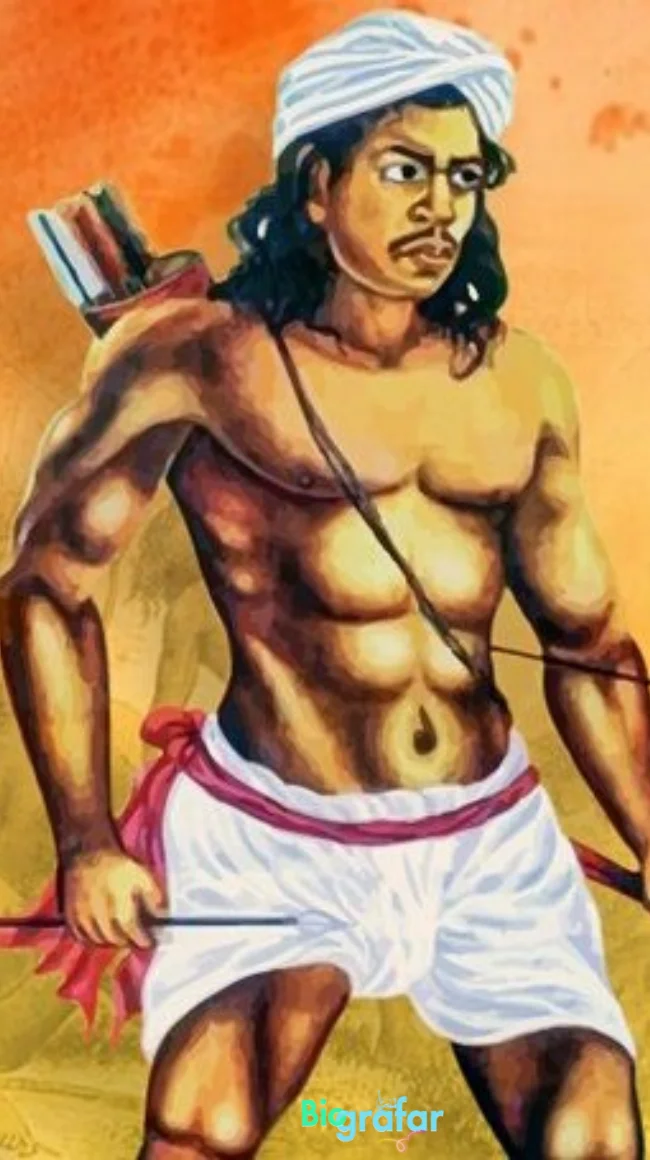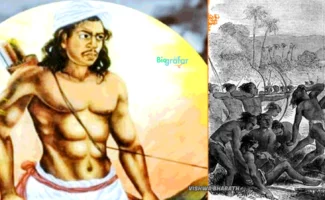Tilka Manjhi: The Tribal Freedom Fighter
Introduction
Baba Tilka Manjhi, also known as Jabra Paharia, emerged as the pioneering Adivasi leader who boldly confronted the British in 1784, a significant seven decades prior to Mangal Pandey’s uprising. His pivotal role involved uniting Adivasis, orchestrating the formation of an armed collective aimed at resisting British exploitation and resource seizure. Born in the tribal heartlands, Manjhi witnessed firsthand the oppression unleashed by the English on his people and their lands. Motivated by a deep-seated commitment to justice, he initiated a rebellion against the British, leading tribal warriors into the forested regions of Bhagalpur and Sultanganj. Manjhi’s early resistance laid the groundwork for future struggles against colonial oppression, marking him as a trailblazer in the fight for Adivasi rights and autonomy.
Heartland Chronicles: Tilka Manjhi's Formative Years
Tilka Majhi, born on February 11, 1750, in Sultanganj, Bihar, hailed from the quaint village of Tilakpur, belonging to the Santhal community. Sundara Murmu, his father, played a crucial role in shaping Tilka's early years. Growing up amidst the rich tapestry of forest civilization, Tilka's childhood was a symphony of adventures—hunting wild animals, engaging in wrestling bouts, climbing towering trees, exploring valleys, and reveling in the company of wild creatures. His daily routine was woven with the threads of nature, meandering through untamed forests and along rivers.Immersed in the wilderness, Tilka developed a profound connection with the natural world, fostering fearlessness and bravery within him. The vibrant landscapes became his playground, and the diversity of wildlife became his companions. This upbringing in the lap of nature not only instilled resilience in Tilka but also laid the foundation for his future endeavors as a leader and freedom fighter. The seeds of courage and fortitude sown in his early years would later blossom into a fervent dedication to the cause of tribal rights and resistance against British oppression.


Igniting the Flame: Tilka Manjhi's Call to Resistance
From his early years, Tilka Manjhi bore witness to the tyranny inflicted by the English upon his family and fellow tribal members. The British rulers exerted their authority over the cultivated lands and untamed trees of the impoverished tribes. Tribal individuals, encompassing children, women, and elderly men, faced severe persecution at the hands of the British oppressors. The Sardars, who inhabited the hill lands, engaged in a valiant struggle against the English government to safeguard their territories.
Mountains harbored landlords who, in a bid to appease the British, facilitated the exploitation of the tribal lands in exchange for financial gains. This systemic injustice and exploitation fueled the flame of rebellion within Tilka. In a historic turning point, Tilka initiated a revolt against the British oppressors. Leading a band of tribal warriors, Tilka charted a course toward the forested realms of Bhagalpur and Sultanganj.
The rebellion spearheaded by Tilka and his tribal comrades marked a resolute stand against the systemic exploitation and oppression inflicted upon their communities. The journey towards Bhagalpur and Sultanganj not only symbolized a physical movement but also a courageous stride towards reclaiming autonomy and justice for the tribal populace. This pivotal moment laid the groundwork for a spirited resistance that aimed to challenge the entrenched powers and restore the rights of the marginalized tribal communities.
The Santhal Uprising: Tilka's Saga in Bhagalpur
Tilka Majhi emerged as a formidable leader during the tribal revolt against the British from 1771 to 1784. In a strategic move in 1778, he joined forces with Pahadia Sardars, successfully wresting the Ramgarh Camp from the British. Tilka’s relentless conflict with the English government led to pitched battles, notably against Cleve Land and Sir Eyre. Employing guerilla tactics, Tilka’s forces engaged in covert attacks, launching arrows on the British army during combat.
A pivotal moment occurred when Tilka, perched atop a palm tree, confronted CleveLand, who approached on horseback. In a display of exceptional skill and bravery, Tilka delivered a fatal blow to Superintendent CleveLand on January 13, 1784, with his arrows. The news of Cleve Land’s demise sent shockwaves through the English government, creating a sense of vulnerability among rulers, soldiers, and officers who found themselves enveloped in an atmosphere of fear.
Tilka Majhi’s strategic prowess and daring actions not only marked a significant chapter in the tribal resistance but also underscored the impact of guerilla warfare against a powerful adversary. His legacy as a fearless leader continues to echo through the annals of history, symbolizing the resilience of those who dared to challenge colonial oppression.
Unity in Arms: Tilka Manjhi's Leadership in Tribal Warfare
In the annals of Indian history, Tilka Majhi stands as a luminary, an unsung hero whose valiant efforts predate even the renowned Mangal Pandey by nearly seven decades. Hailing from the Santhal community, Tilka's early life in the quaint village of Tilakpur was infused with the essence of forest civilization. His father, Sundara Murmu, guided him through the shadows of the wilderness, where Tilka honed his skills in hunting wild animals and traversing the rugged terrain. His daily routine included activities that forged a connection with nature, instilling in him fearlessness and bravery.The spark of resistance ignited in 1784 when the first armed rebellion against the British unfolded, marking the nascent stages of the Santal movement. The year itself became synonymous with defiance as Tilka Majhi orchestrated a courageous uprising against the British oppressors. The backdrop of this rebellion was set by the great famine of 1770 and the ramifications of the Court of Directors' order influenced by William Pitt the Younger. The directive, issued in 1800, minimized negotiation opportunities between local Zamindars and Santhal villagers, exacerbating the exploitative relationship.Tilka, fueled by the rampant resource grabbing and exploitation by the British, undertook the formidable task of organizing Adivasis. He rallied them into an armed collective, presenting a united front against colonial plunder. This resistance, driven by Tilka's visionary leadership, encapsulated the determination of a community fighting for autonomy and justice amidst the oppressive colonial regime. Tilka Majhi's indomitable spirit and early endeavors laid the foundation for a prolonged struggle, inspiring generations to come in their quest for freedom.
Mountain Refuge: Tilka's Escape from Treachery
In the midst of revelry during a celebration of dance and songs, a treacherous turn unfolded for Tilka Majhi and his revolutionary comrades when a betrayer, Warlord Jaudah, launched a sudden attack on the Santhali army. In this unexpected invasion, Tilka managed to survive, but the cost was heavy – numerous soldiers became martyrs, and some were unjustly imprisoned. Fleeing from the aftermath, Tilka sought refuge in the mountainous terrain of Sultanganj.The English army, relentless in their pursuit, laid traps in the surrounding mountain areas of Sultanganj and Bhagalpur. Tilka, now leading a camouflaged existence in the mountains, faced the harsh realities of life. His army struggled against hunger and starvation, with many succumbing to these adversities. Undeterred, the valiant captain and his forces engaged in guerrilla warfare against the British.The Santhal tribals, led by Majhi, fiercely confronted the English army in a series of skirmishes. However, the odds were stacked against them, and Majhi found himself ensnared by the British forces during the relentless conflict. In a tragic turn of events, the heroic freedom fighter was captured, marking a poignant chapter in the indomitable journey of Tilka Majhi and his unwavering fight against British oppression.
The Brutal End: Tilka Majhi's Gruesome Capture and Execution
In the grim culmination of his relentless struggle against British oppression, Tilka Majhi faced a horrific fate in 1784. Captured by the British forces, he endured a brutal ordeal, symbolizing the ruthlessness of colonial rule. Tied to the tail of a horse, Tilka was subjected to a dehumanizing journey, dragged across the rugged terrain to the collector’s residence in Bhagalpur, Bihar, India.
The ordeal did not end there. Upon reaching the collector’s residence, Tilka’s battered and lacerated body bore witness to the extent of his suffering. The colonial authorities, seeking to extinguish the flame of rebellion, chose a Banyan tree as the macabre stage for Tilka’s final chapter. There, in a grotesque display of power, they hung his lifeless form—a stark and harrowing spectacle meant to serve as a warning to others who dared challenge the British dominion.
Tilka Majhi’s tragic fate stands as a testament to the brutal reprisals faced by those who dared to resist colonial oppression. His sacrifice, though met with cruelty, echoes through history as a symbol of unwavering defiance in the face of tyranny.
Legacy Enshrined: Tilka Manjhi's Monument and Bhagalpur University Renaming
A monument honoring the indomitable spirit of Tilka Majhi stands proudly at the very location where he endured the brutal act of being hanged, a chilling testament to his unwavering commitment to the cause of freedom. Following India’s independence, this spot near the residence of S.P. Bhagalpur was chosen to erect a statue in his memory, paying homage to the sacrifices made by this valiant freedom fighter.
Moreover, the city of Bhagalpur acknowledges Tilka Majhi’s profound impact by renaming its university in his honor. The Bhagalpur University, now known as Tilka Manjhi Bhagalpur University, serves as a living tribute to his legacy, ensuring that his name is forever etched in the annals of education and enlightenment.
The renaming of Bhagalpur University reflects a broader recognition of Tilka Majhi’s role in shaping the course of history. It signifies a collective acknowledgment of his resilience, bravery, and sacrifice, inspiring generations to come. As students walk the corridors of Tilka Manjhi Bhagalpur University, they are reminded of the man who fearlessly challenged oppression, embodying the ideals of freedom and justice.
In this emblematic gesture, the university becomes not just a center of academic pursuit but a living monument to the valorous soul who fought for the liberation of his people. Tilka Manjhi’s heritage endures not only in the struggles of his time but in the enduring structures and institutions that bear his name, ensuring that his story remains an integral part of the artistic and educational heritage of Bhagalpur
Conclusion:
In summary, Tilka Manjhi’s life serves as a powerful testament to the resilience of the human spirit and the transformative influence one person can wield in shaping history. His enduring legacy resonates across the ages, underscoring the profound impact individuals can have when they stand against oppression. Tilka Manjhi story is an alleviation reminding us that indeed in the face of adversity the unvarying commitment of a single individual can bring ripples of change that extend far beyond their time. His insuperable spirit remains a guiding light for those who aspire to challenge injustice and pave the way for an unborn defined by freedom and justice.